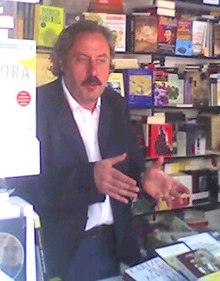Julio Llamazares
Julio Llamazares (* 1955 in Vegamián, Spain ) is a Spanish author .
Life
He was born in 1955 in Vegamián, a small, isolated village in the province of León in northwestern Spain, the son of an elementary school teacher, and spent his childhood there. The village disappeared under the water of the Juan Benet reservoir on June 23, 1969 . Many of his novels are set in his home region and deal with the loneliness and seclusion in the northern Spanish mountains. Because of this topic, Llamazares occupies a special position in contemporary Spanish literature, as he is one of the few authors who dealt with the rural and peripheral regions of Spain and their decline. He thus addresses rural-urban migration in Spain and draws attention to the relentless modernization process associated with it.
At the age of 12, Llamazares left his home region and went to boarding school in Madrid . Upon completion of the high school he decided to jurisprudence to study. Today, however, he mainly works as a journalist , writer and screenwriter in Madrid and León .
plant
After his first two volumes of poetry La lentitud de los bueyes (1979) and Memoria de la nieve (1982) he became a successful novelist in 1985 with Luna de lobos (made into a film in 1987; German Wolfsmond , 1991). His works are characterized by a sometimes depressingly hard and gripping narrative style. His big breakthrough came in 1988 with his novel La lluvia amarilla (German: The Yellow Rain , 1991) about an old man and his struggle against nature and loneliness in a deserted village in the Pyrenees . The book already had 15 editions in the first three years after publication. In 1994 his novel Escenas de cine mudo (German silent film scenes , 1998) about a childhood in a mining village was published .
Llamazares also has stories such as B. En mitad de ninguna parte (1995), chronicles such as El Entierro de Genarín (1981) and an anthology on Madrid, Los viajeros de Madrid (1998). His journalistic work is collected in En Babia (1991) and Nadie escucha . He also published travelogues such as B. El río del olvido (1990) and Tras-os-Montes (1998), in which he mostly writes about forgotten areas.
His work Flores de otro mundo (1999; Eng .: Flowers from another world ) was also made into a film and was shown in German cinemas in 2001.
Works
- La lentitud de los bueyes. (German. The slowness of the ox. 1979; poems), Suhrkamp Verlag , ISBN 3-518-39580-7 .
- Luna de lobos. (Ger. Wolfsmond. es. 1985; Ger. 1991; Roman), Suhrkamp Verlag, ISBN 3-518-38705-7 .
- Escenas de cine mudo. (German silent film scenes. 1998; novel), Suhrkamp Verlag, ISBN 3-518-12044-1 .
- Stone Roses - Spanish Cathedrals from Santiago to Segovia. translated by Astrid Böhringer. Hanser, Munich 2011, ISBN 978-3-446-23746-9 .
Web links
- Literature by and about Julio Llamazares in the catalog of the Ibero-American Institute in Berlin
- Literature by and about Julio Llamazares in the catalog of the German National Library
- Literature by and about Julio Llamazares in the catalog of the library of the Instituto Cervantes in Germany
Individual evidence
- ↑ Between the stones an abundance of glass. In: FAZ . January 12, 2012, page R 5.
| personal data | |
|---|---|
| SURNAME | Llamazares, Julio |
| ALTERNATIVE NAMES | Llamazares, Julio Alonso |
| BRIEF DESCRIPTION | spanish author |
| DATE OF BIRTH | 1955 |
| PLACE OF BIRTH | Vegamián, Castile and León , Spain |
